Imagine a fish that combines the head of a toad, bioluminescence, poisonous spines, and an ability to produce sound so pronounced that it was once blamed for keeping part of an entire city awake. This is no science fiction fantasy or deep sea mystery. It’s a creature that often lives under our very feet as we walk the beach during low tide. This utterly unusual animal is a fish – the Midshipman, Poricthyus notatus.
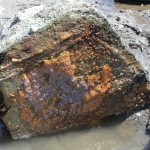
A large boulder turned over in a mud flat at low tide reveals thousands of Midshipman eggs attached to the underside.
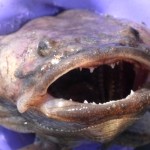
The male Midshipman who was hunkered down under the rock and a good look at the toothy mouth he used to defend his brood. Note the line of photophores under the jaw.
The name of this animal, every bit as unusual as its demeanor, originates from the rows of photophores that line the underside of the fish. Early mariners were obviously impressed at the resemblance of these organs to the buttons on a midshipman’s uniform – hence the name. Depending on the source consulted these very noticeable photophores are used to attract prey, confuse predators, or attract a mate. Most likely they are used by the creature for all of these purposes at one time or another. As expected for an animal with such an ability the Midshipman is a nocturnal species, and considering the fact that several hundred photophores line the upper ventral sides of the fish that bioluminescence must be quite a show.
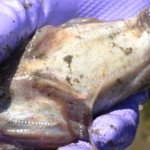
A look at the underside of the animal displays the “Midshipman” lines of photophores used to attract prey and mates.
Odd as it is, however, this is not an uncommon fish. About fifteen different species of Midshipman inhabit marine coastal waters from tropical climes to northern waters in the east and west coast of North America. Yet despite this widespread range and the ability to produce “biological light” the Midshipman is more apt to be heard than seen. In fact it is their vocal talents that have made the Midshipman famous, or infamous, in most quarters. The vocal talent of this fish is so pronounced it has earned the nickname of “Sea Canary.” The fish produces the sound thanks to an adaptation of their swim bladder. There are two basic vocalizations – a rough grunt and a long, low hum; kind of like a soft trombone. They have annoyed and disturbed the sleep of many houseboaters and caused considerable confusion for kayakers. Perhaps the most famous accusation came from West Seattle where the fish was blamed – by experts – for a strange unidentifiable hum heard throughout that section of the city. King 5 News, the local CBS affiliate, did an extensive story on the incident in September 2012.
Nocturnal by habit the Midshipman burrows under rocks and mud during the day. These burrows serve as breeding sites and males vigorously guard the eggs they have fertilized in their carefully prepared nests. Turning over good sized rocks along a muddy beach when the tide is out sometimes reveals the thousands of eggs and the very upset father guarding them.
Midshipman are members of a group of fish called the Toadfish. As you might expect from an animal thus named the thing does have sort of a toadish appearance with its wide flattened head and exceptionally large mouth. Not the most beautiful example of our finned friends toadfish are downright dangerous looking and often have a disposition to match. They don’t have warts, of course, but sport spines which in some species are painfully poisonous. And unlike terrestrial toads, toadfish possess an impressive array of teeth, effective weapons for guarding eggs or catching the smaller fish and crustaceans that make up their diet.
Which brings to mind another odd characteristic of the Midshipman – they have three sex types: Female, Male Type 1, and Male Type 2. The female of the species is a bit larger than her male suitors. Type 1 males are distinguished by a much larger body mass and vocal organs than the Type 2 males, but the Type 2 male compensates for this disparity by having much larger sex organs. This is one odd fish!
If you’d like to see a Midshipman for yourself they are not so hard to find. The next time you happen to be strolling about one of our fine Pacific beaches, or perhaps somewhere else up and down the coast, take a moment and turn over a good sized rock. If a small pool of water appears under that rock don’t step or reach into it carelessly. You might be rewarded with a strange grunting sound and a sudden painful jab from a fish spine. And you will know immediately that you have found a Midshipman fish. But no matter how painful or exasperating the sting do the right thing and carefully replace the rock. Then come back some quiet night and listen for the eerie sound of a fish singing.
HOOAH
Jack

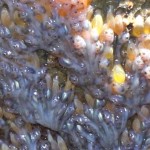
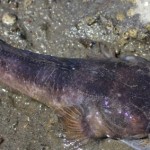
Leave a Reply
You must be logged in to post a comment.